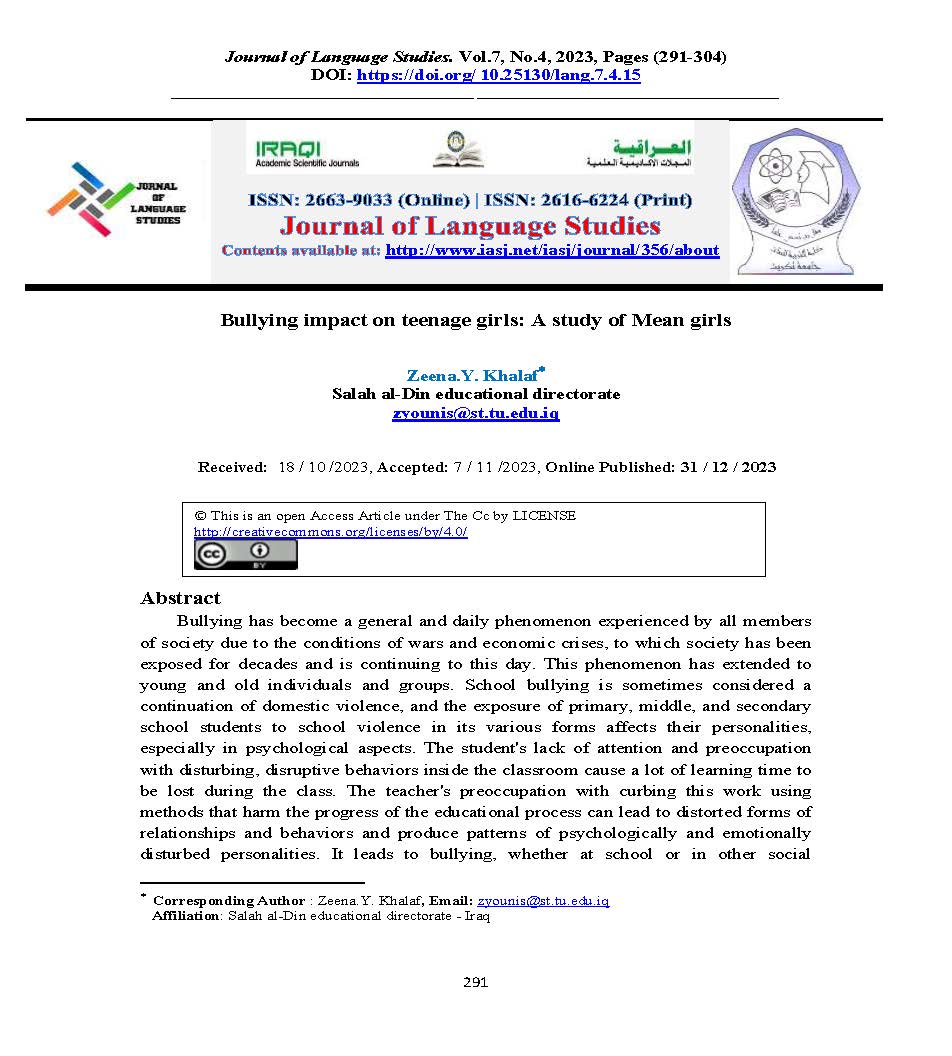Bullying impact on teenage girls: A study of Mean girls
DOI:
https://doi.org/10.25130/lang.7.4.15Keywords:
School Bullying, Types of Bullying, Treating Bullying, Bullying Teenage GirlsAbstract
Bullying has become a general and daily phenomenon experienced by all members of society due to the conditions of wars and economic crises, to which society has been exposed for decades and is continuing to this day. This phenomenon has extended to young and old individuals and groups. School bullying is sometimes considered a continuation of domestic violence, and the exposure of primary, middle, and secondary school students to school violence in its various forms affects their personalities, especially in psychological aspects. The student's lack of attention and preoccupation with disturbing, disruptive behaviors inside the classroom cause a lot of learning time to be lost during the class. The teacher's preoccupation with curbing this work using methods that harm the progress of the educational process can lead to distorted forms of relationships and behaviors and produce patterns of psychologically and emotionally disturbed personalities. It leads to bullying, whether at school or in other social institutions. Bullying is such a fundamental problem in our schools and society because it impacts a large number of students of all races, genders, and socioeconomic statuses. Here, the researcher identified types of bullying and described the impacts of bullying in the "Mean Girls" movie.
References
Works Cited
Adams, Richard. "Girls more likely to be bullied than boys, English
schools survey finds". The Guardian. 2019.
Al-Saleh, Tahani. The degree of manifestations and causes of aggressive
behavior among primary- stage students in government schools in the northern governorates of the West Bank and methods of treating it from the point of view of teachers. Nablus, Palestine. College of Graduate Studies at An-Najah National University. 2012.
Charmaz, Kathy. Constructing grounded theory. London: Sage. 2006.
Cornell, Dewey. " School climate and bullying" .curry school of
education. university of Virginia. 2011.
Fey, Tina. Mean girls. United States. 2006
Gordon, Sherri. “Do boys and girls bully differently?”. Verywel Family.
James Alana. School bullying report. London, UK: NSPCC Research
Briefing. 2010.
Khoj, Hanan. “School bullying and its relationship to social skills among
primary school students in Jeddah, Kingdom of Saudi Arabia.” Journal of Educational and Psychological Sciences, December issue. King Abdulaziz University. 2012.
Klomek, Anat Brunstein. The Association of Suicide and Bullying in
Childhood to Young Adulthood: A Review of Cross-Sectional and Longitudinal Research Findings. La Revue canadienne de psychiatrie, vol 55, no 5. 2010.
Mahmoud, Sherine. Bullies and their victims. Al-Arabi Magazine, Issue
2015.
Massad, Abu Al-Diyar. The psychology of bullying between theory and
treatment. Kuwait, second edition. 2012.
McCrone, William. "school bullying a problem for deaf and hard of
hearing students?". INSIGHTS & STRATEGIES. 2004
Mishna, Faye; Saini, Michael; and Solomon, Steven. Ongoing and online:
Children and youth’s perceptions of cyber bullying. Children and Youth Services Review 31. 2009.
Mohammed. Mariam Kadhem, and Abdullah. Ansam Riyadh, Bullying
Concept in Richard III and Kawakami's Haven,in Vol 15, No 54 June 2023. in
https://www.iasj.net/iasj/download/5c559d3650acff00.
Mohammed, Ashraf. School bullying among secondary school students.
Journal of Educational Sciences. 2018.
Olweus , Dan. "Bully / victim problems un school". prospects. vol . xxvi.
No.2. 1996.
Olweus , Dan. "The nature of school bullying : A cross- national
perspective". London : Routledge. 1999.
Paudel Subedi, Krishna, Kumari. "Theoretical Perspective of Bullying".
International Journal of Health Sciences and Research. Vol: 10, Issue: 8, August 2020.
Pearl Ben, Elana. Cyberbullying. Nemours teens health. 2022.
Salmivalli , C.; Kaukinen, A.; Kaistaniemi , L. and Largerspetz ,K. Self-
Evaluated Self-Esteem, Peer-Evaluated Self-Esteem, and Defensive Egotism as Predictors of Adolescents' Participation in Bullying Situations. "Personality and Social Psychology Bulletin". Vol 25, No 10. 1999.
Sayhi, Salima. "Journal of Social Change, School Bullying, Educational
Study". Issue 6. 2019.

Downloads
Published
Versions
- 2023-12-31 (2)
- 2023-12-31 (1)
